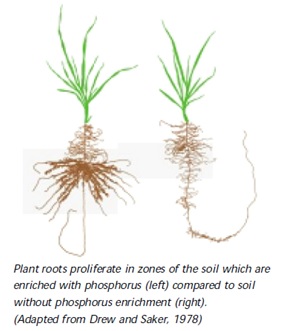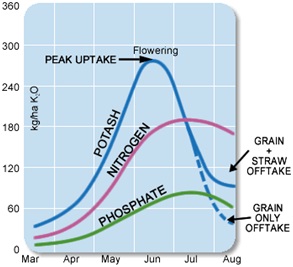PK timings
As customers get the combines out, some are also turning their thoughts towards next season and what will need doing for the new crop. Cropping plans are starting to roll in to the Applications Team inbox so fertiliser can be ordered in the hope of a good harvest and drilling conditions, allowing for an autumn application of phosphate and potash (P&K).
There are two common questions we often get asked; "When should I apply my P&K?" and "Are there any fields I should prioritise?' Although there are always other factors which will influence timings of P&K, it is important to consider the indices of your fields. Hopefully the next few paragraphs will offer some guidance on this based around RB209 and practical knowledge.
Phosphate
Phosphorus (P) is a key component of root growth, energy release and energy movement. Due to these benefits, it is vitally important that there is enough available phosphate in the soil and that it is readily available at drilling to get the crop well established.
- If at least 50% of the field is at index 1 or below, all of the crops' P requirements should be applied to the seedbed and worked in.
- If over 50% of the field is at index 2 or above and little or none at index 0, P can be applied at any point in the year or when workload allows.
This is the standard advice from RB209 but I think you also want to ensure that you are getting the best possible value out of the fertiliser you have purchased. For example, if your soil is of a high pH, you have large P requirements and you are drilling a winter crop, you are at higher risk from lock up if you apply large amounts of P in the autumn where crop uptake is low. In these scenarios, you may want to consider applying a small amount of P into the seedbed at drilling and then the main dose of P very early in the spring, ready for the period of high crop requirement.This strategy should help to get the most benefit from the fertiliser applications.
If you have P indices at an index 2, if possible, I would still recommend applying very early in the spring or autumn to maximise any potential yield benefits. You want to ensure you are feeding the crop and pushing it as close to its full yield potential – not just fertilising the soil. If you apply P any later than mid-spring, there would be almost no benefit to the current crop as the main period of uptake will nearly be over, only then benefitting the following crop.
Potash
Potash (K) is used as a catalyst for chemical exchanges within the crop and is key to controlling water content within the cells. Potassium is taken up in massive quantities during the growing period - up to 400kg/ha dependent on the crop - although much of this is returned to the soil during senescence. It is important to consider your soil types alongside your indices when thinking about K, as potassium is held on exchange sites of clay particles and organic matter, with only very small amounts held in the soil solution.
Winter crops
- If 50% of the field is at an index 1 or 0 and on a light soil (less than 10% clay and 15% silt), half the planned K should be applied to the seedbed and the remainder in the spring.
- For all other soil types, where 50% of the field is at an index 1 or 0, all of the K should be applied to the seedbed.
- If at least 50% of the field is index 2 or above and little or none at index 0, K can be applied at any time.
As with the P, K uptake is at its highest during the spring so it would be recommended that all K is applied by the early spring to ensure you are feeding the large K requirement of the crop. Anything later than mid-spring will feed the soil, with little benefit to the current crop.
Spring cereals
- If 50% of the field is at an index 1 or 0 and on a light soil (less than 10% clay and 15% silt), apply the K between January and sowing, when conditions allow.
- For all other soil types, where 50% of the field is at an index 1 or below, all of the K should be applied between autumn and sowing.
- If at least 50% of the field is index 2 or above and little or none at index 0, K can be applied at any time.
With spring cereals it would be suggested that K is not applied any later than mid-spring. Many spring crops move through the growth stages quickly so you do not want to miss the opportunity to feed the crop. Therefore, applications of K either just before, at, or just after drilling would be advisable.
Remember – never apply fertiliser if:
- The soil is waterlogged, flooded, frozen or snow covered.
- Heavy rainfall is forecast in the 48-hours after a planned application.
Gavin Campbell Applications team leader | Jeremy Hollis Soil scientist
As a subscriber, you’ll receive email alerts each time a new blog is published so you can always stay updated with the latest advice and insights from our experts





Comments